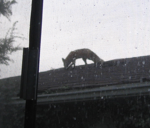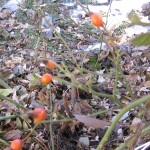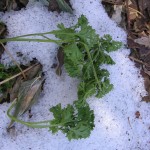Plant people long for Spring. Looking at all the seed catalogs is cool, but having the little green beings sprouting and hanging out with them is really totally cool! In the dead of winter there is nothing as wonderful as some snippet of green to perk up a meal.
I noticed that the Sunflower Market still has herbs for sale in little pots. That gave me an idea! How about a big pot with three herbs in it to snip for those winter meals? What a great gift for myself and for my foodie friends. All those paper whites and tulips are fabulous flowers and add good color just when we need it, but herbs? They bring us fragrance, flavor, and can be planted in the flower bed or garden come Spring!
If fact, I think I’ll just open a couple of seed packets and start some right now! Or shall I make mine weeds? Sorrel, plantain, clover, and purslane maybe…yum!

 As people encroach on the wilderness, the amount of wild life that shows up in the cities is increasing. It used to be that there was an occasional sighting of deer or bear or other interesting creatures out of their element in an urban setting. Police would be called, animal catchers would round up the culprits, and soon it was people in the city and animals in the wild once more.
As people encroach on the wilderness, the amount of wild life that shows up in the cities is increasing. It used to be that there was an occasional sighting of deer or bear or other interesting creatures out of their element in an urban setting. Police would be called, animal catchers would round up the culprits, and soon it was people in the city and animals in the wild once more.
 If I actually left my yard, what wonders could I find? For one thing, there are many roots besides the dandelions in my yard. There are burdock and yellow dock for sure, and their dead leaves would lead me to them. Also cattails have many possibilities for food year around, as do birch trees, willows, balsam fir, pine needles, blackberry bushes, and clover.
If I actually left my yard, what wonders could I find? For one thing, there are many roots besides the dandelions in my yard. There are burdock and yellow dock for sure, and their dead leaves would lead me to them. Also cattails have many possibilities for food year around, as do birch trees, willows, balsam fir, pine needles, blackberry bushes, and clover.

